Explore the latest news and find out what's on this month
Explore our learning offer for schools, families and community groups
Uncover the rich history of Elmbridge with our latest online exhibitions
Want to discover more about your local area?
Explore the latest news and find out what's on this month
Explore our learning offer for schools, families and community groups
Uncover the rich history of Elmbridge with our latest online exhibitions
Want to discover more about your local area?
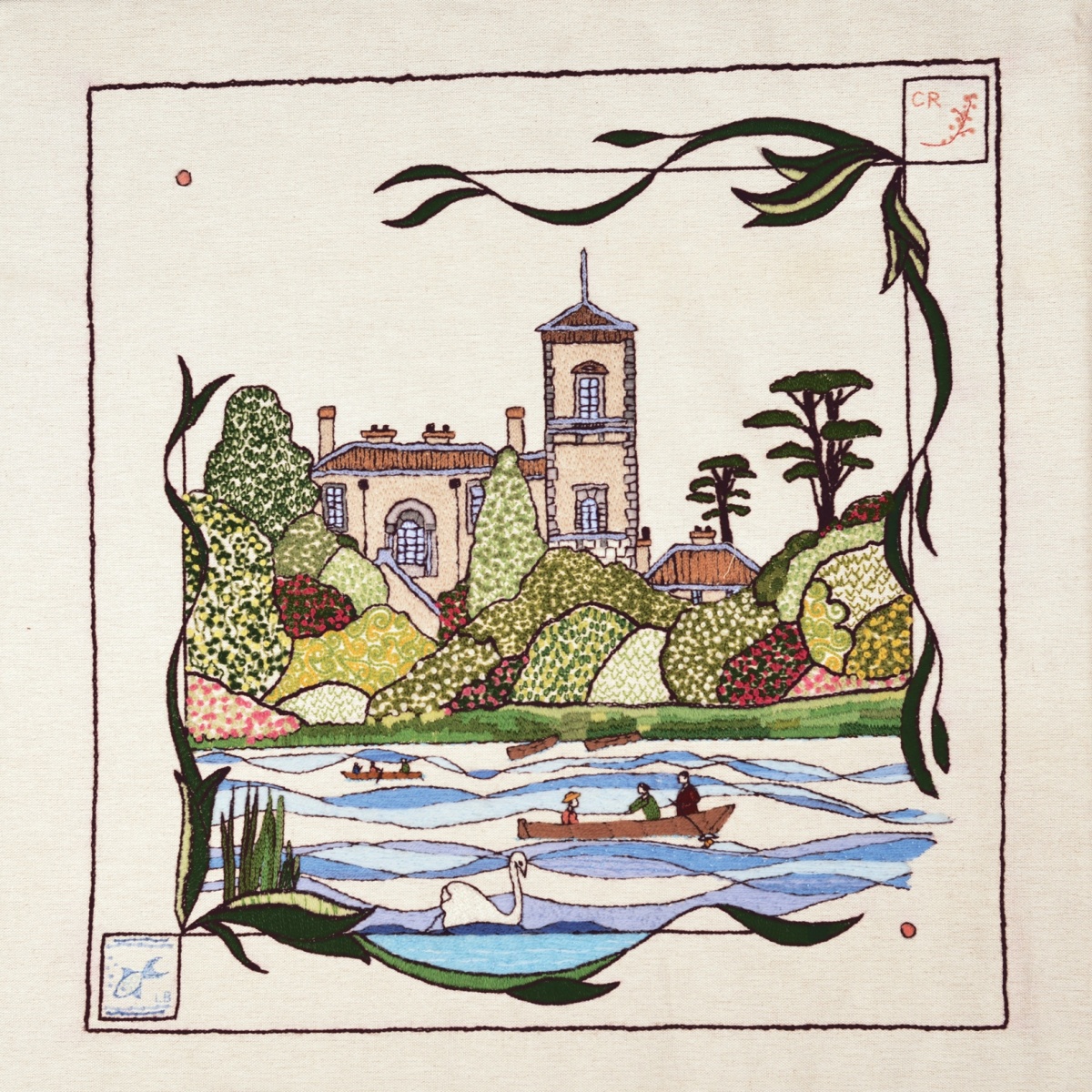 Panel 2 of the Mount Felix Tapestry: 'Mount Felix Before the War' © Riverhouse Barn.
Panel 2 of the Mount Felix Tapestry: 'Mount Felix Before the War' © Riverhouse Barn.
The local area played its own part, and in 1915 Mount Felix – a grand estate next to the river in Walton – was converted into a hospital for wounded New Zealand soldiers fighting for the British Empire.
A century later, in 2015, the Riverhouse Barn Arts Centre, R.C Sherriff Trust and Elmbridge Borough Council therefore decided to embark on their own centenary project: the Mount Felix Tapestry. This community stitch project saw over 600 volunteers from across the local area dedicate more than 6,000 hours to help bring to life 44 embroidered panels telling the story of Mount Felix, designed by artist Andrew Crummy.
The tapestry returned from an 18 month tour of New Zealand in 2019. In 2022, for the first time ever, we opened a temporary exhibition pairing 17 of the tapestry panels with original photos from the hospital in Elmbridge Museum’s collection, and display objects linked to ANZAC soldiers’ experiences in the First World War.
This online exhibition tells the fascinating story of Mount Felix, its patients and nurses. Most importantly, it demonstrates how most lives were irreversibly changed by the War, with its effects reverberating far and wide well after the Armistice and into the present day.
The exhibition is free to visit at House of Killik, Esher High Street, and some of the items and photographs included can be explored in this online exhibition.
Learn more about the Mount Felix Tapestry here
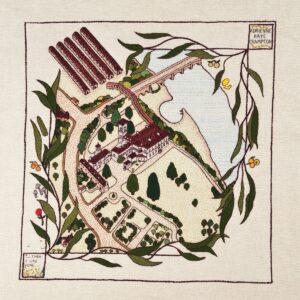
Panel 20 of the Mount Felix Tapestry: ‘Anzac Mount’ © Riverhouse Barn.
The Mount Felix mansion was built in the early 1700s as a grand country house. Its position on the River Thames meant that, in 1750, its owner oversaw the construction of the first Walton Bridge next door to the house. By 1905, Mount Felix was a family home, but less than 10 years later, in 1914, the First World War was declared. In October that same year, 8,454 New Zealand soldiers volunteered to join the war effort fighting for the Allies, with this number increasing upon the introduction of conscription. Many of these men fought in the Gallipoli Campaign from April 1915 – January 1916, which would see a staggering 28,150 casualties within their ranks. It was the year this brutal campaign began, in 1915, that Mount Felix was offered up for use as a 150 bed hospital for ANZAC (Australian and New Zealand Army Corps) First World War servicemen.
In January 1916, five large timber ward huts were built to the south of Bridge Street between Oatlands Drive and the River Thames, increasing the bed capacity to 1,040. Named Anzac Mount, this area was linked to the main buildings by a covered walkway and a footbridge. By May 1916, a New Zealand Medical Board was established with a view to setting up further hospitals.
58% of all New Zealand troops were either killed (16,697) or wounded (41,317) during the course of the war. The military hospitals at Mount Felix and Oatlands Park between them treated 27,000 patients over this time, putting into context how vastly important they are to New Zealand’s war history.
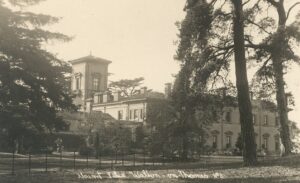
A postcard of Mount Felix in November 1914, before it was requisitioned for use as a military hospital.

A postcard of Mount Felix just before the outbreak of war, in 1914.
This bullet has been attached to a pin and inscribed with ‘France’ in blue enamel on one side. Trench art was commonly made by servicemen as a souvenir and often saw the repurposing of bullets and other equipment.
The 1914-15 Star medal. This was awarded to all British and Imperial forces of the First World War, after pressure for recognition from dominion governments across the British Empire. This medal was awarded to a Private W. Shields.
The Victory medal. This medal was awarded to all those British and Imperial forces of the First World War who had received the 1914-15 Star medal. This medal was awarded to a Private W. Shields.
A mounted button from a New Zealand serviceman’s uniform. The button is made of brass and bears the words ‘New Zealand Forces’ and four stars in the centre.
Princess Mary’s Christmas Fund tobacco tin. This tin was issued to Imperial troops fighting for Britain during the winter of 1914. It bears the names of the Allies and contains the original packets of tobacco and cigarettes.
The Overseas Club Certificate. This was issued to local school girl Emma Denby for helping to collect money for Christmas day gifts to be sent to Britain’s Imperial forces fighting in the First World War in 1915.
A First World War bayonet with wooden grip, in a leather and steel sheath, 1907. This demonstrates the kind of weapons a soldier on the front line may have carried.
Certificate of recognition of service in the First World War by Oliver Roy Haase in the New Zealand Expeditionary forces. It contains a drawing of Brittania with lions at her feet, and a member of the New Zealand forces signing a paper held by her.
These bronze memorial plaques were issued to relatives of British and Imperial troops killed on active service in the First World War. It reads "He died for freedom and honour" and bears the name "John Fuller". They were also known as Dead Man's Pennies.
An unused postcard from the Daily Mail Official War Pictures series, entitled 'R.A.M.C picking up wounded in a captured village.' The description explains that 'These are the King's soldiers and our comrades who have fought and suffered. The best we can give them is their due. Such is the feeling of the devoted Red Cross Service. It demonstrates the level of danger and destruction faced by soldiers on the front line in the First World War.
A view of Mount Felix mansion when it was being used as a military hospital for New Zealand soldiers from 1915-19. The view is from the driveway, flanked by large flower-vases, looking towards the building. A flag staff bears the flags of New Zealand and the Red Cross, and a group of three people stand in the foreground.
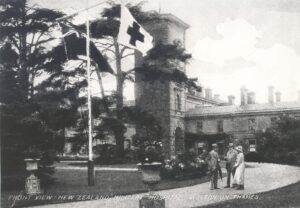
This postcard of Walton shows nursing staff of the New Zealand Military Hospital at Mount Felix posing for a group photograph with some army personnel. Several are seated, the rest are standing, and the nurses wear traditional First World War nursing uniforms.

This postcard was published to commemorate the visit of King George V, Queen Mary and Edward, Prince of Wales, to the New Zealand Military Hospital at Mount Felix in 1917. The King is stood fourth from the left in the front row, with the Queen stood to his right. Many of the soldiers and nurses at the hospital are stood around them.
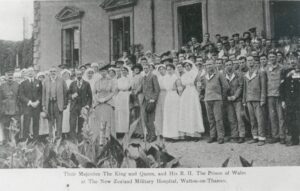
This sepia postcard of the Broadwater, in Weybridge, shows it frozen over during one winter in the First World War. Numerous locals stand on the ice, mixing happily with the staff and patients from the New Zealand Military Hospital at Mount Felix. On the back of the postcard, a note reads that nurse Henderson was holding the reins of the sleigh.
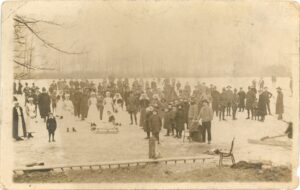
This postcard of Mount Felix is entitled ‘New Zealand Hospital, taken on the bridge.’ A ward orderly and several troops stand in the left foreground on the covered bridge, from which there is a general view of the hospital buildings on the right, including the ‘Lord Plunket Shelter’. This shelter was named after New Zealand’s former Governor General, and was designed to be moved around the grounds and angled to the sun for health benefits. In total, eight members of the Plunket family worked at Mount Felix, with 4 of Lord Plunket’s daughters acting as pantry maids and his son working as an orderly.
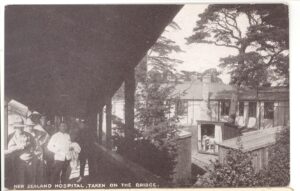
This postcard of the New Zealand hospital at Mount Felix, Walton, shows soldier patients and nurses standing on the steps of the house. In the front is an older patient in a long lie-back wicker push-chair with large wheels, and many of the surrounding soldiers use crutches or wear bandages.
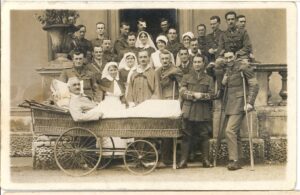
This photo shows nurses and patients inside a ward at Mount Felix Hospital.
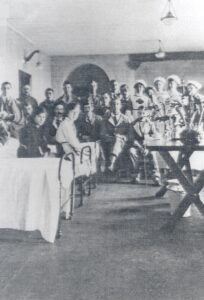
A sepia photograph of a group at a wedding at Mount Felix Military Hospital, c.1915-16. The wedding group are mainly New Zealanders, and the donor’s wife sits in the front row with a baby on her lap. There were many instances of patients at Mount Felix marrying nurses or locals during their time there.
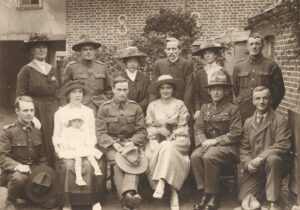
This photograph of Mount Felix Military Hospital was taken sometime between 1915-20. In the official photo, a large group of nurses and patients stand outside the building, while some too unwell to join them look out from the windows.
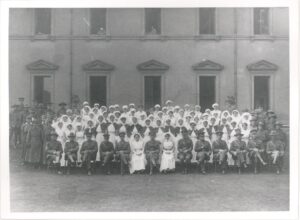
This photograph shows a procession during the 1918 peace celebrations in Church Street, Walton. Some New Zealand soldiers are visible in the crowd, distinguishable by their ‘lemon squeezer’ slouch hats. Although the Armistice was a joyous occasion, for many the war affected them long after victory. Families in New Zealand grieved for loved ones buried overseas, and many of the soldiers that passed through Mount Felix would be affected by their wounds for the rest of their lives. Even this victory gathering took place in the shadow of St. Mary’s Church, where some of those New Zealand soldiers who did not survive are buried.
Although the war was over, Mount Felix continued to operate as a military hospital with a gradually decreasing number of patients, eventually closing in March 1920, six months after its counterpart at Oatlands Park had shut its doors for good.
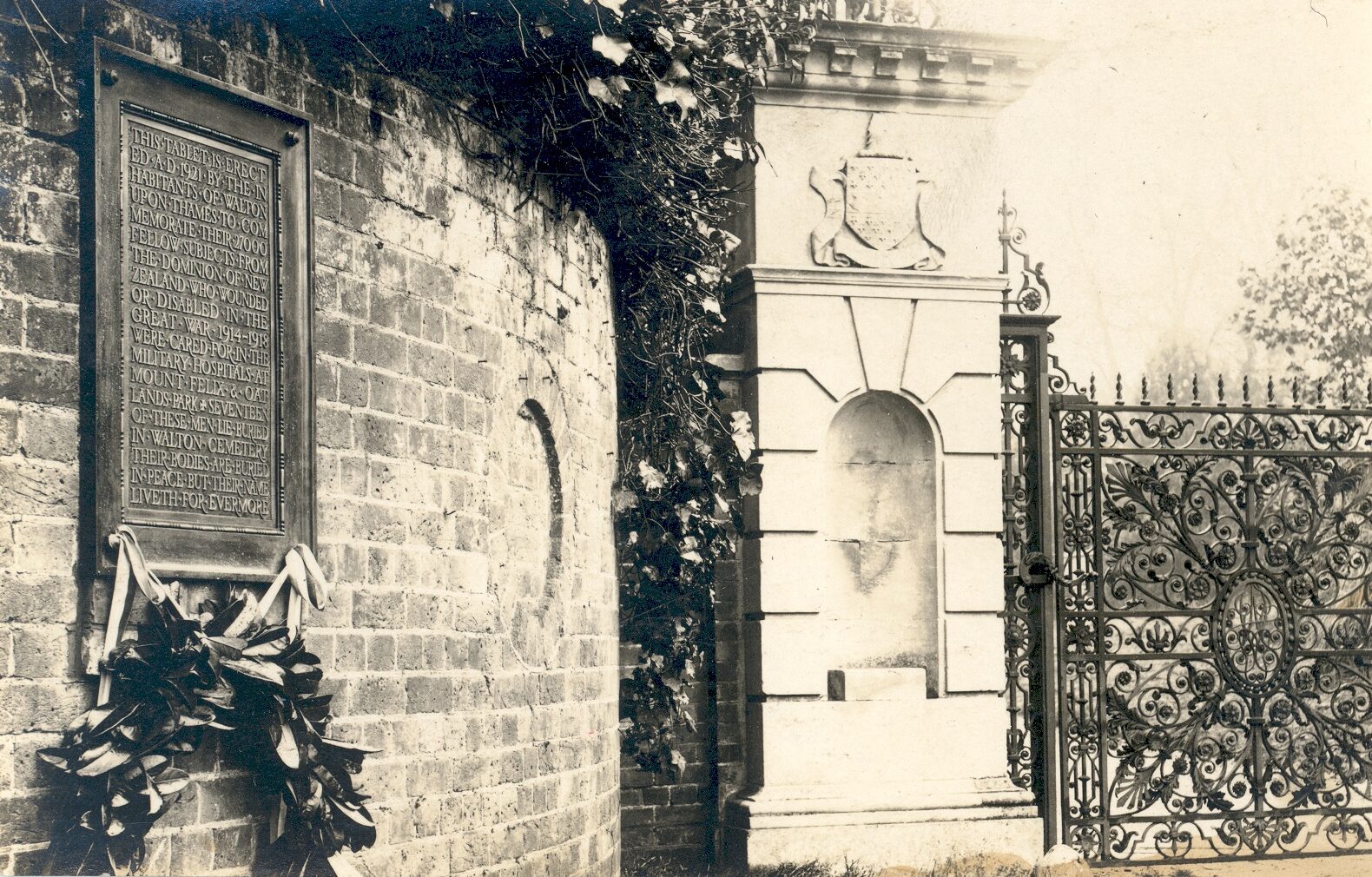 The New Zealand War Memorial tablet, on the wall adjoining the main entrance gates of Mount Felix. It was unveiled by the Honourable Sir James Allen K.C.B., the High Commissioner for New Zealand on the 20th November 1921.
The New Zealand War Memorial tablet, on the wall adjoining the main entrance gates of Mount Felix. It was unveiled by the Honourable Sir James Allen K.C.B., the High Commissioner for New Zealand on the 20th November 1921.
The New Zealand War Memorial Tablet originated when the work of the military hospitals at Oatlands Park and Mount Felix was complete. In 1921, former staff at the two hospitals reported to the Council that a total of 27,000 New Zealanders had passed through these institutions.
The memorial tablet cost £70.10 in total to create and put up, of which £28.4.6 was collected from the community by eight individuals by means of collecting cards. The tablet is currently located in Elmbridge Museum.
The inscription on the New Zealand War Memorial Tablet
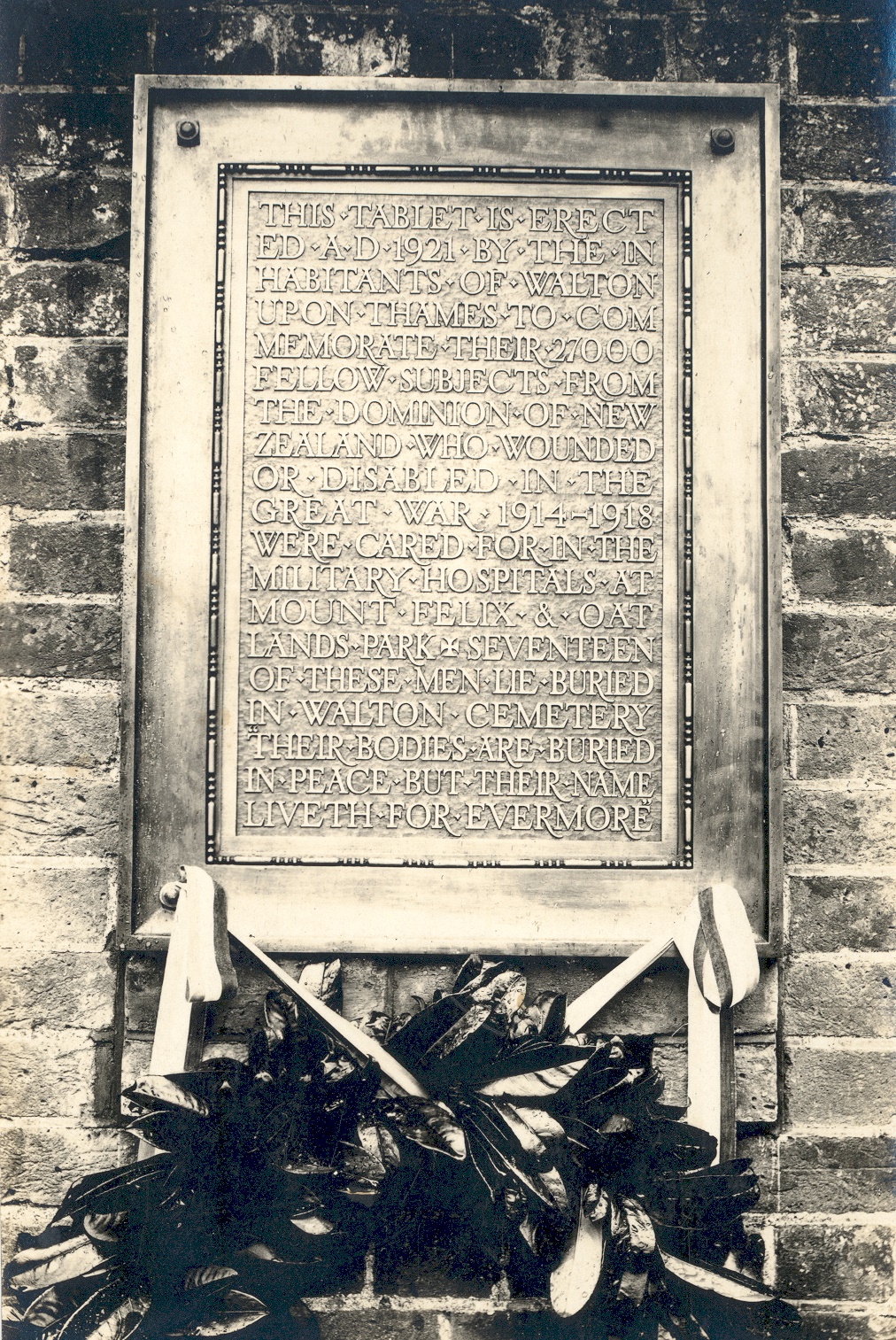 The New Zealand War Memorial tablet, on the wall adjoining the main entrance gates of Mount Felix. It was unveiled by the Honourable Sir James Allen K.C.B., the High Commissioner for New Zealand on the 20th November 1921.
The New Zealand War Memorial tablet, on the wall adjoining the main entrance gates of Mount Felix. It was unveiled by the Honourable Sir James Allen K.C.B., the High Commissioner for New Zealand on the 20th November 1921.  ‘New Zealand Thanks’ Address. This document was produced in 1919 by New Zealand’s Parliament. It thanks all service personnel and those who helped them in 1914-18 war.
‘New Zealand Thanks’ Address. This document was produced in 1919 by New Zealand’s Parliament. It thanks all service personnel and those who helped them in 1914-18 war.
The commemoration of New Zealand troops in Walton took place abroad as well as at home. Almost a year after the war’s end, a ‘New Zealand’s Thanks’ address was issued by the country’s Parliament. A copy was sent personally to the Mayor of Walton from New Zealand’s Prime Minister, W.J Massey.
It commemorates all those, from New Zealand and further afield, who fought on behalf of the Allies in the Great War, those who helped them in their times of need, and those who died for their country.
One section in particular may have resonated with many of the people who were treated and worked at Mount Felix:
“To all who offered the hand of fellowship to New Zealand soldiers and nurses.
That this House, in the name and on behalf of the people of the Dominion, places on record its deep sense of appreciation of the many kindnesses, courtesies, and privileges extended to the members of the New Zealand Expeditionary Force on active service in various parts of the world. To each and all, in whatever part of the world, who offered the hand of fellowship to New Zealand Soldiers and Nurses who helped to cheer and comfort them, whether in hospital, in camp, on furlough, or en route to and from the seat of war, the Dominion tenders its grateful thanks.”
 The tower of Mount Felix falling during demolition, 1967.
The tower of Mount Felix falling during demolition, 1967.
After the First World War’s end, Mount Felix was returned to its original owners, but then swiftly sold on by them due to its poor condition. The building was converted into flats and fully inhabited for many years, but this was not the end of its war story.
The outbreak of the Second World War in 1939 saw the mansion’s grand ballroom put to use again. This time, it acted as a mortuary for the 83 people killed in the devastating German air raid on the Vickers-Armstrong aircraft factory at Brooklands in September 1940, and families came to Mount Felix to identify the bodies of their relatives.
In the years after the Second World War, the ballroom was occasionally used for shows and inhabitants continued to occupy the flats there. However, a huge fire in June 1966 which started in one of the rooms on the first floor sadly saw more than half of the upper floor and roof structure destroyed. It resulted in the total demolition of the main house and tower in 1967.
Only the old stable block and clock house survive today, now in use as offices.
Find out more about the history of remembrance and the First World War in Elmbridge in our 100 Years of Remembrance exhibition, for which students from Hinchley Wood Secondary School reflected on what remembrance means to them.
Go to the online exhibition
Leave a Comment
We'd love to know what you thought of this online exhibition, or if you have your own memories of Mount Felix.You need to be logged in to comment.
Go to login / register